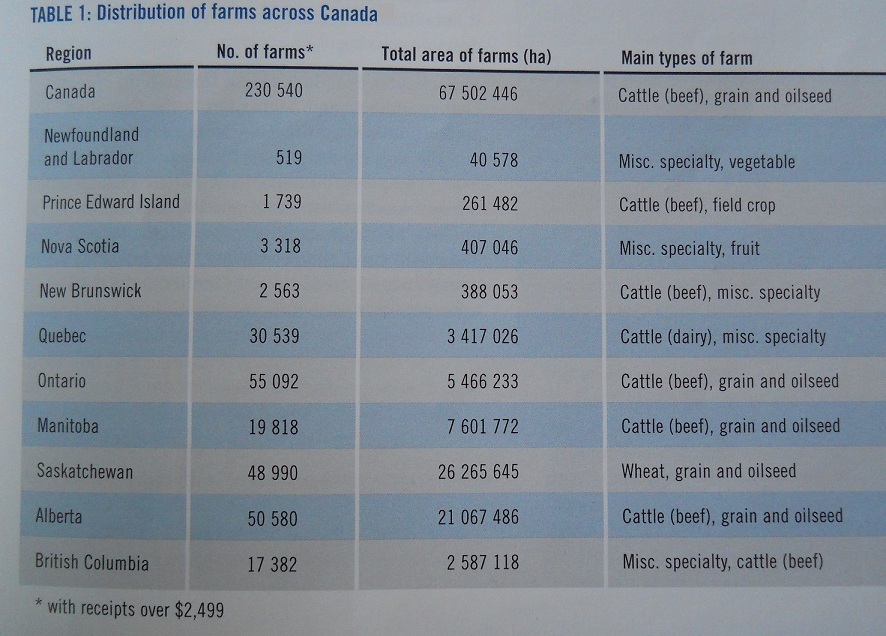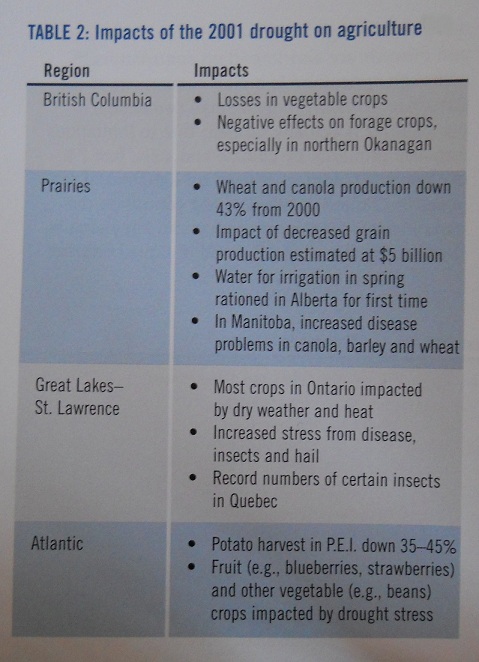AGRICULTURE
(Canada in a Changing Climate)
Agriculture is inherently
sensitive to climate… Without adaptation, climate change is generally
problematic for agricultural production and for agricultural economies and
communities; but with adaptation, vulnerability can be reduced…”
In 1998, the Canadian agriculture and agri-food industry
generated approximately $95 billion in domestic revenue, and was the third
largest employer in the country. Canada’s
agri-food exports in 2000 were valued at $23.4 billion, accounting for 6.1% of
total merchandise exports. Farming
operations are spread across Canada,
with the greatest area of farmland located in the Prairie Provinces (Table 1). Cattle and
dairy farms account for the highest amounts of farm cash receipts, although
wheat, canola, and other cereals and oilseeds are also important
contributors. Although agriculture is a
vital component of the Canadian economy, only a small percentage of our country
is actually farmed. Due to limitations imposed primarily by climate and soils,
just 7% of Canada’s
landmass is used for agricultural purposes.
Climate is also a strong control on the variation in year-to-year
production. For example, the drought that plagued much of Canada during
2001 seriously impacted farm operations. Water shortages and heat stress in
some regions of Saskatchewan and Alberta have
significantly lowered crop yields and threatened the availability of feed and
water for livestock. Some other impacts of the 2001 drought are listed in Table
2. In certain areas of the Prairies, 2001 was part of a multiyear drought that
extended into the summer of 2002.
Many believe that the consequences of the 2001 drought may
be indicative of what the agriculture sector in Canada can expect more frequently
in the future. Climate change could lead to more extreme weather conditions,
increases in pest problems, and severe water shortages. On the other hand, a
warmer climate and longer growing season could benefit many aspects of Canadian
agriculture. In general, experts agree
that future climate changes of the magnitude projected by the Intergovernmental
Panel on Climate Change would result in both advantages and disadvantages for
the agricultural sector in Canada, and that the impacts would vary on a
regional basis.
A key factor in determining the magnitude of climate change
impacts on agriculture is adaptation.
Appropriate adaptations would allow agriculture to minimize losses by
reducing negative impacts, and maximize profits through capitalizing on the
benefits. There are many different adaptation options available to the
agricultural sector, which vary greatly in their application and approach. Selecting and implementing adaptation
strategies will require consideration of the physical, socioeconomic and political
influences on agriculture, as well as the contributing roles of producers,
industry and government. It is also necessary to recognize that climate change
is just one of many challenges facing the agricultural sector, and that it may
not be considered a short-term priority in decision making.
TABLE 1:
Distribution of farms across Canada

TABLE 2: Impacts of the 2001 drought on agriculture



